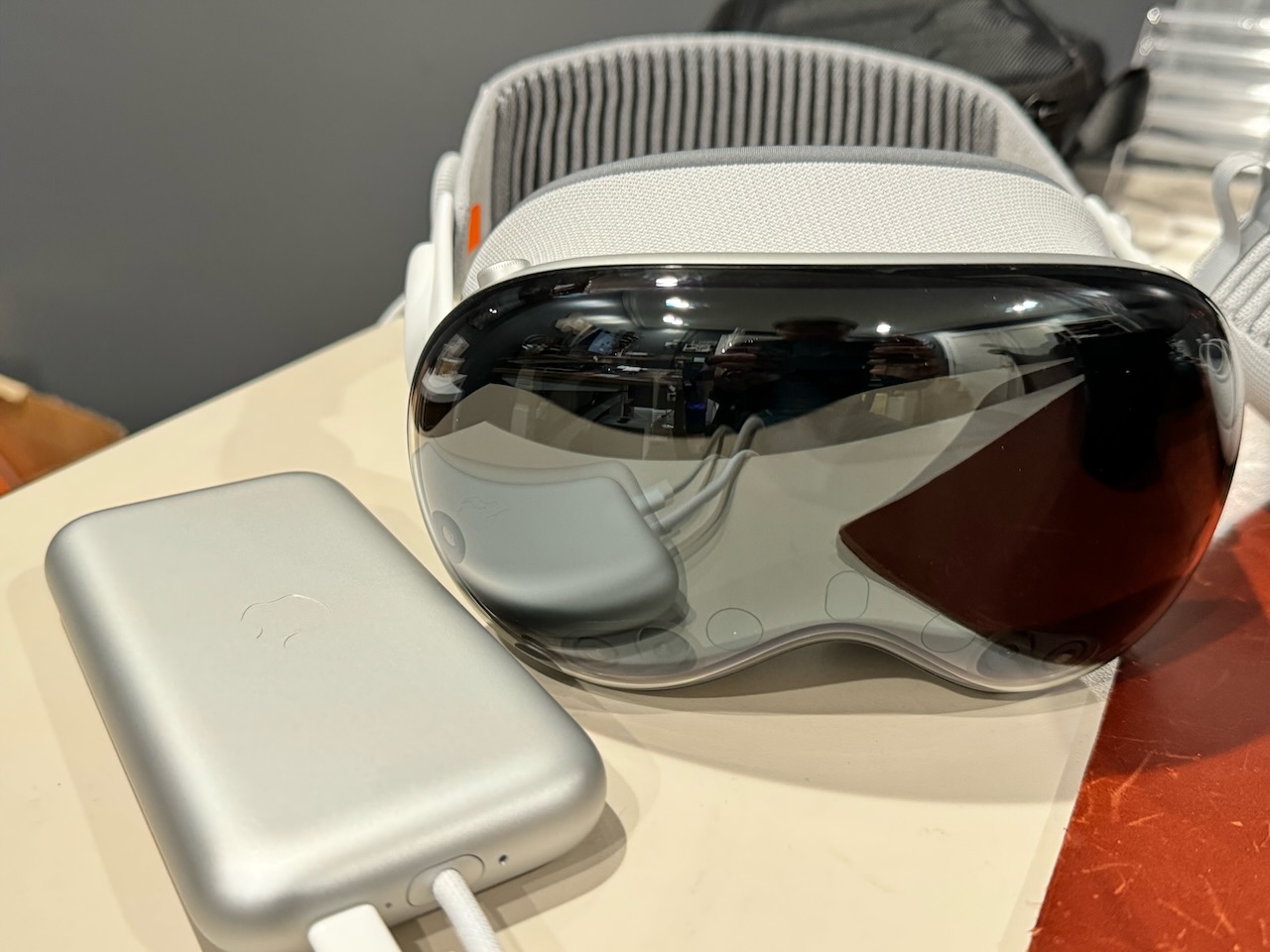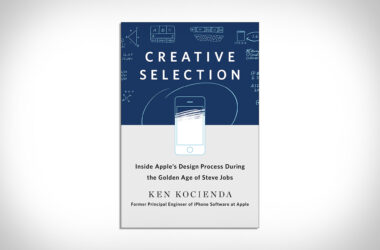The reality of Apple hardware launches is that there’s no shortage of previews, reviews, first impressions, hot takes, and thought pieces about what it all means—leading up to, during, and after the launch event itself. It’s an all-encompassing media bubble, which kept me distracted and entertained as I waited for my own headset to arrive1. Watching and reading reviews helped set expectations on how well its headline features work and how ridiculous the thing looks on peoples’ faces.
The abundance of media means that there’s little need to repeat the headset’s specs, how the “spatial computing” UI/UX works, etc. Nevertheless, some quick impressions:
- The Vision Pro is heavy; it is not comfortable to wear for long periods.
- It makes for an awesome TV- and movie-viewing experience, where the added depth of the displays makes an expanded screen feel like IMAX.
- While the Personas are unsettling, the ability to easily scan my face to create the avatar, and then mimic facial expressions in real-time with cameras, is technically very impressive.
- Given how few units are expected to sell and the difficulty in developing for the Vision Pro before this launch, I’m surprised at how many native apps are available this early.
As this site is about creating space for reflection, here are some thoughts on what this device portends—while trying to avoid the knee-jerk hyperbole that sometimes comes with new hardware products.
Communicating Experience
Whenever there’s a hardware transition, there also needs to be a way to simulate a user’s experience with that new hardware. Sometimes, it’s pretty straightforward: if you watch a video review of a foldable phone, you have a good sense of how that phone feels, with the possible exception of knowing how well the hinge works. When smartwatches launched, they were similar enough to fitness trackers, in that they were outfitted with familiar screen and battery technology, combined with the materials from traditional watches. That combination made it easy to extrapolate how smartwatches would look and feel.
The Vision Pro’s challenge is trying to provide a user experience that isn’t easily simulated by other existing hardware. Though it’s hardly the first VR headset—the first Oculus Rift shipped 8 years ago—nobody is reading about or watching 3D videos of Apple’s new system in a Meta Quest or PlayStation VR helmet. Apple went to the trouble of setting up extensive, 30-minute demos of its device in Apple stores because the experience is so difficult to convey in words and photos and videos2.
Perhaps eventually, we’ll all be wearing augmented glasses that project 3-dimensional video into our eyeballs. In that technological future, we immediately can grok how a new set of glasses makes that media look 30% better. But until we do, there’ll be a heavy amount of editing and post-processing to get the point across. Kinda like the Vision Pro tutorial.
Wearable Ergonomics
The advent of battery technology, combined with wireless radios, has exploded the breadth of wearable gadgets: wireless earbuds, smartwatches, fitness-tracking rings, smart glasses with embedded microphones and speakers, etc. Since these things go on our ears, hands, and faces, manufacturers have accommodated comfort and fit by providing multiple sizes and minute variations of their hardware. High-end earbuds usually come with multiple ear tips3; smart rings go through a fitting process not unlike how precious metal rings are sized; smartwatches just use the standard case and watch strap measurements from the mechanical watch world.
The Vision Pro takes its ergonomics seriously. It comes with 2 straps, a face scan to select 1 of 28 light shield sizes, plus another pair of regular and wide cushions for optimized fit. Separately ordered, custom lenses help with myopia and presbyopia, as there’s no real way to get a tight fit onto the face with bulky glasses in between4. When you put it on, it has to calibrate the position of the lenses, adjust its cameras to correctly recognize your irises and hands, and will proactively warn the user if the headset deviates from its calibrated, ideal face placement.
It turns out that the human body is a mess of weird angles and joints that don’t conform well to the clean lines of modern industrial design. The smartphone converged into a burgeoning slab of metal and glass, but that was only possible because there were enough aftermarket accessories—like the PopSocket—that solve some of its ergonomic pitfalls, namely the unwieldy size and weight that make it uncomfortable to hold. Similarly, there’s a healthy market for handheld grips for portable consoles5 as the flat controller cramps the hands over time.
If this trend of intimate, personalized input and output devices continues, then I hope we standardize how we calibrate our bodies to new hardware. Instead of every new system coming up with ways to track our eyes, hands, and facial features, it’d be nice to do it once, and then transfer that calibration data across devices. I guess technically this would be considered Protected Health Information, but it seems like it’s on the same level as, say, prescription lenses measurements.
Pushing Compute
For many of our everyday computing devices, we’ve reached the point of “good enough” for the vast majority of consumers, in the vast majority of their use cases. One easy tell is how often people upgrade their hardware: nowadays, people keep their phones for 3–4 years easily, while laptops and desktops also don’t get replaced for 5+ years6. Not only is the hardware mature and stable, but there’s no quality-of-life improvement that would merit the costs.
The VR/AR/XR/SC7 space is one of the categories of devices where upon using one for an hour, you can conclude that the technology just isn’t there yet. Even with rumored manufacturing costs of $1,700, there are still many areas where you can feel the inadequacy of the current software and hardware, and would have to trust that the 4th, 5th iterations of this category would be when it’d reach its potential:
- The cameras can be sharper and higher-res;
- The battery life should be much longer, even though it’s already 3 iPhone batteries stacked on top of each other;
- The processors can run cooler;
- The field of view can be wider, with more pixels rendered;
- The eye- and hand-tracking can be more precise;
- The overall device can be lighter and less bulky
These improvements aren’t about component costs or software immaturity, but more about cutting-edge manufacturing processes, miniaturization, battery and compute efficiencies, etc. that only improve with more time and iterations. And it’s not just technologist snobbery here; there are enough compromises in the above design decisions that real utility is sacrificed to get this headset to market in 2024. A rough metaphor would be if other VR headsets—the Meta Quest line, the Valve Index—have been building Priuses and Lexus hybrids, while Apple is out here cobbling together a few thousand Model S EVs at tremendous cost, but with hints of the electric vehicle revolution to come.
This is pretty exciting! We have needed a category of personal computing that would force hardware development and manufacturing to get better, not continuously miniaturizing for its own sake but having a tangible impact on user experience and therefore mass market adoption. Even if the Vision Pro and its successors ultimately don’t catch on, the earnest attempt with this device8 and the vision that it’s targeting, should pull the state of consumer technology forward.
The Verge’s video review deserves a special mention for adding field-of-view and distortion effects to tweak the video capture to match how it looks inside the headset.↩
There are good aftermarket options too; I like Comply and their foam tips.↩
To be fair, custom prescription lenses have been available for other headsets, the Vision Pro is hardly the first.↩
With a related category of grip controllers attached to phones for mobile games.↩
Beyond consumer trends, this is doubly reinforced by corporate policies on how often company laptops get replaced.↩
Spatial Computing, at Apple’s insistence.↩
And to be realistic, the latest in a long line of middling to failed VR/AR devices, from Google Glass to the Snap Spectacles.↩



